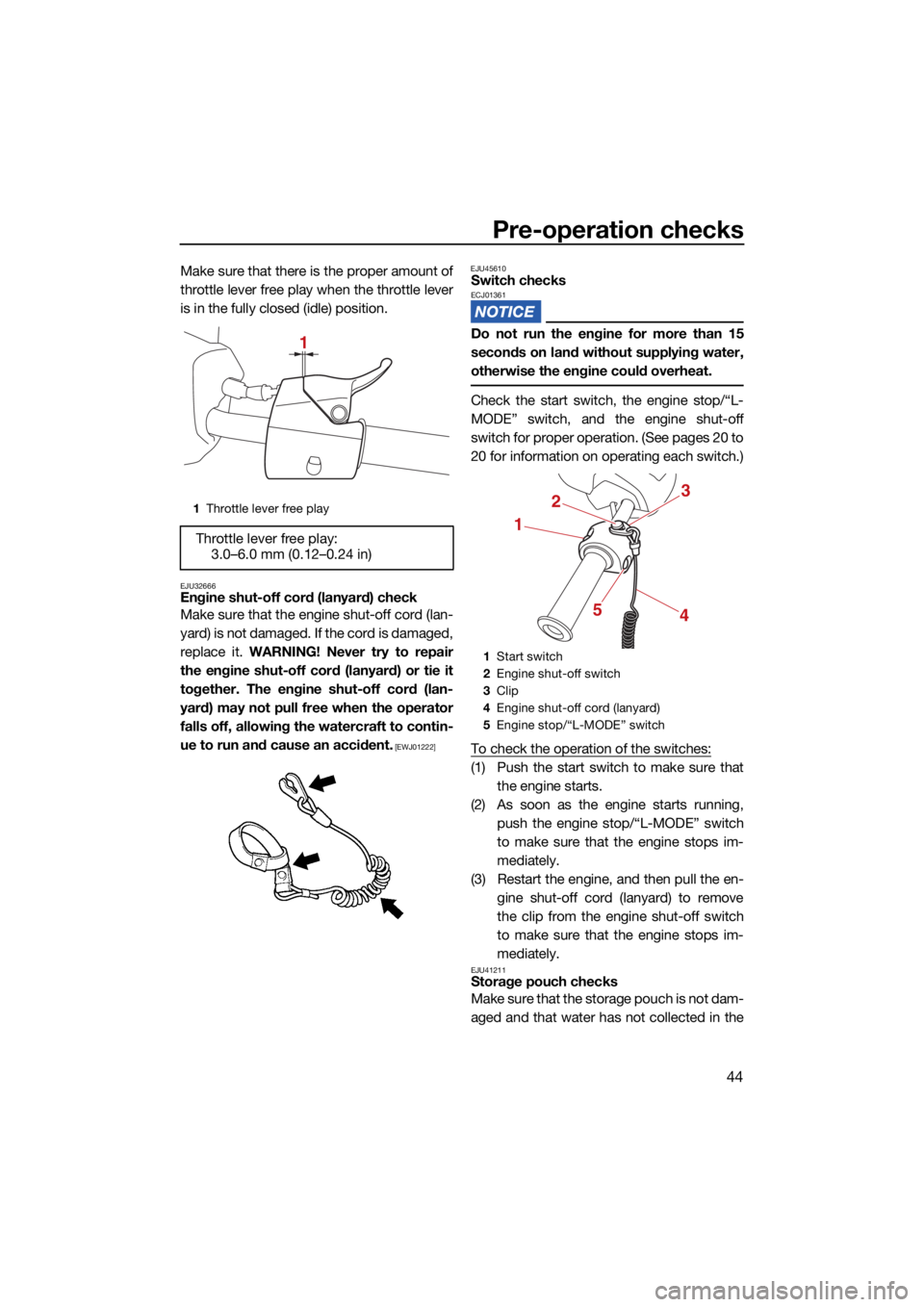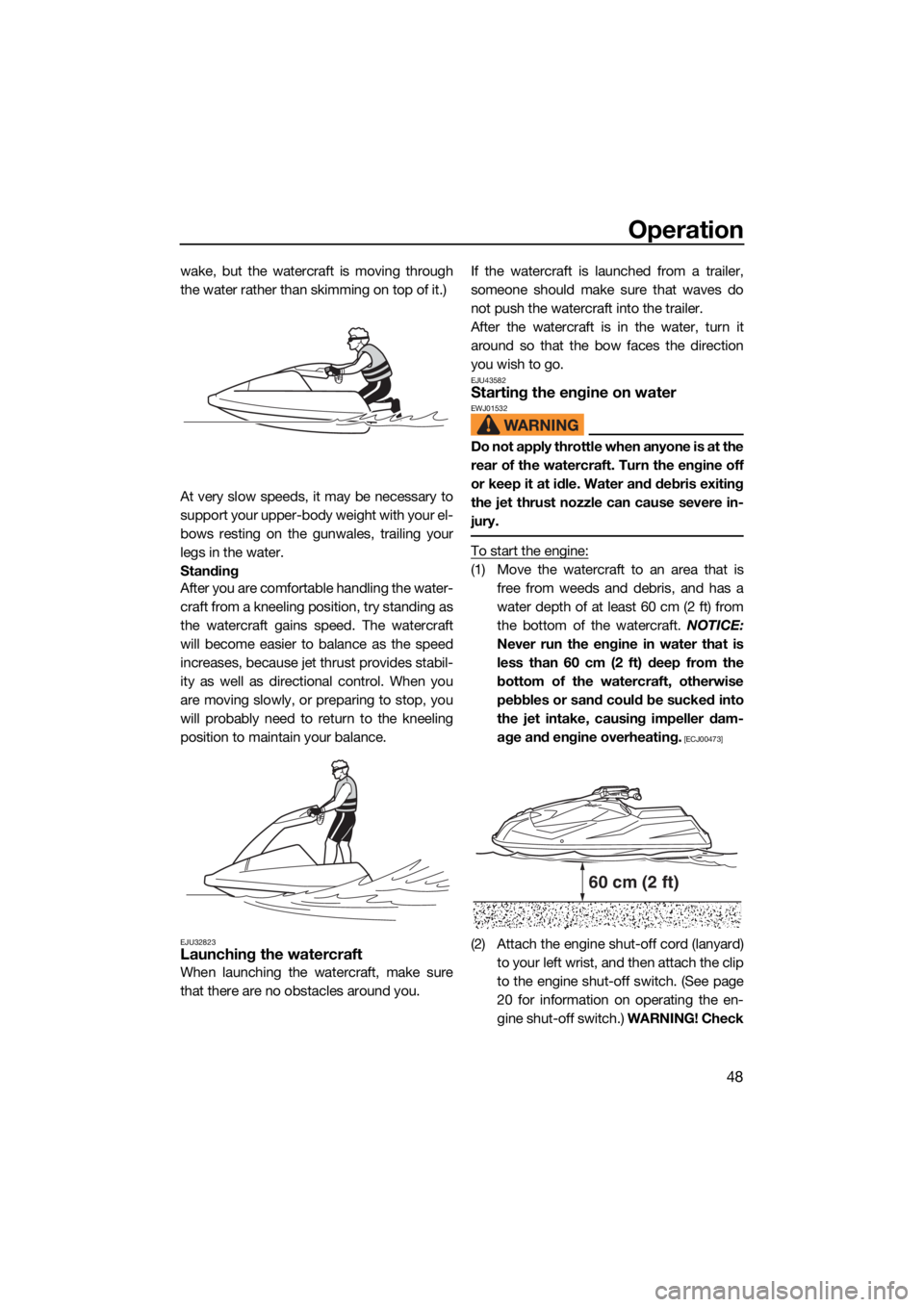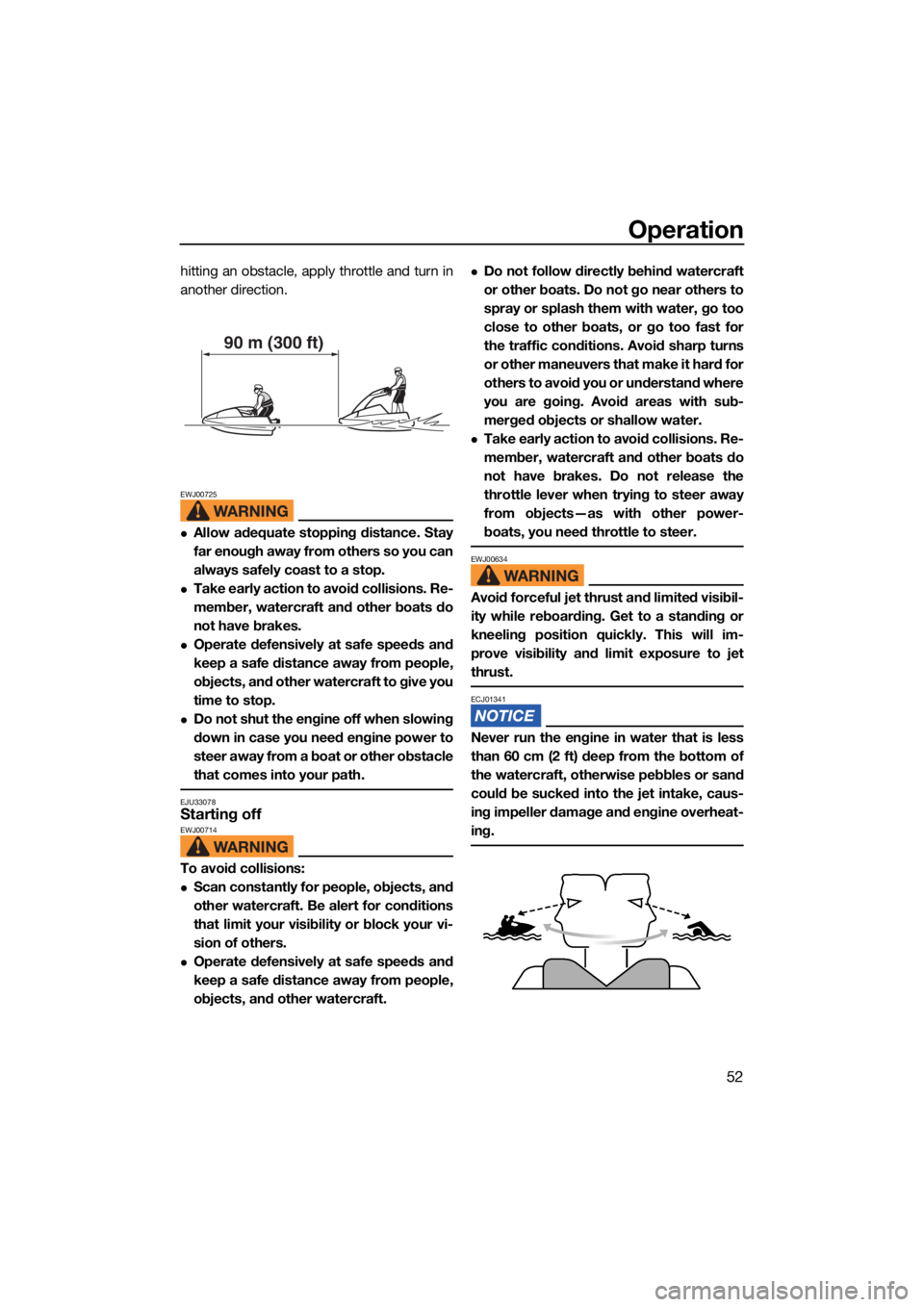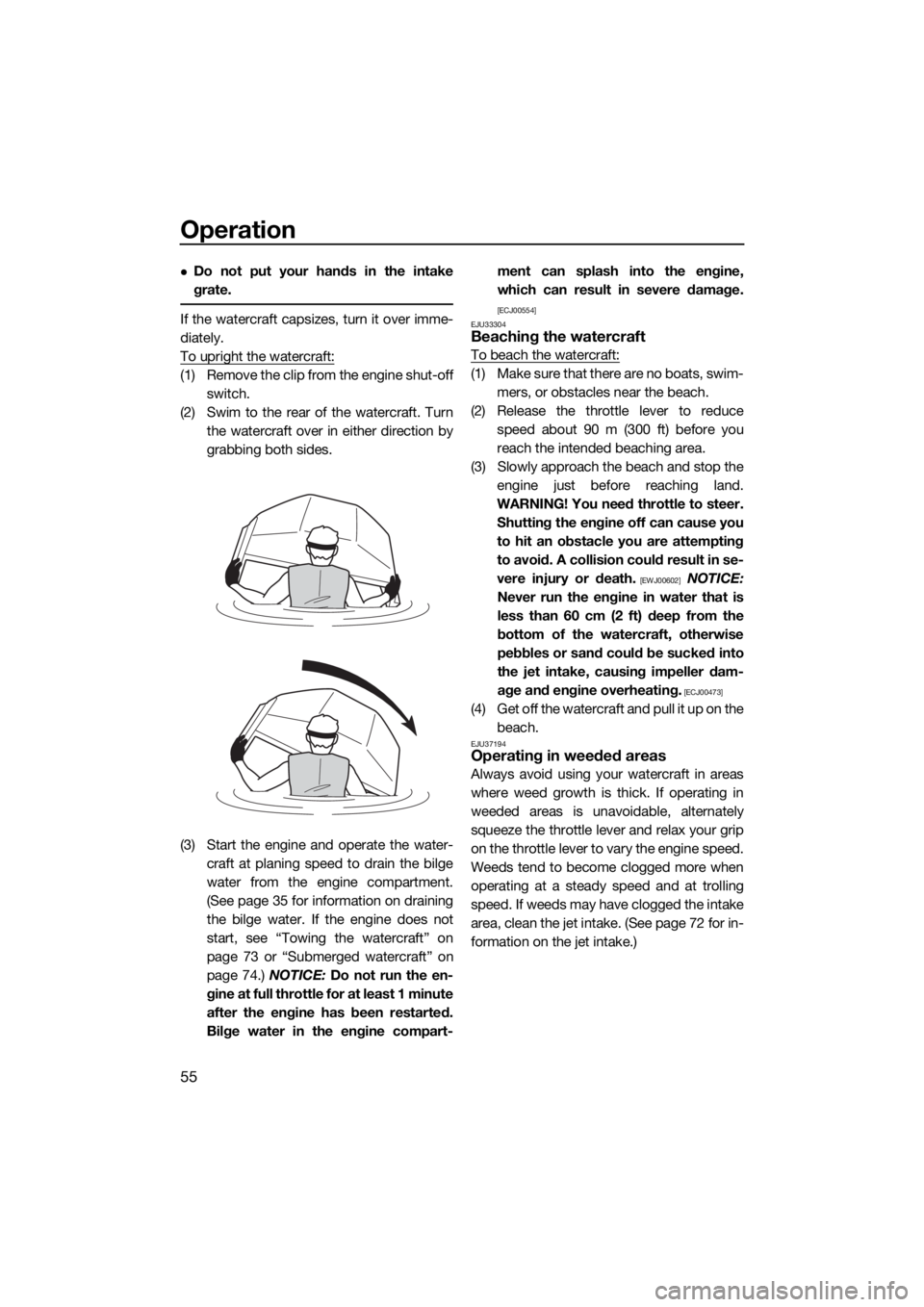stop start YAMAHA SUPERJET 2022 User Guide
[x] Cancel search | Manufacturer: YAMAHA, Model Year: 2022, Model line: SUPERJET, Model: YAMAHA SUPERJET 2022Pages: 84, PDF Size: 3.76 MB
Page 51 of 84

Pre-operation checks
44
Make sure that there is the proper amount of
throttle lever free play when the throttle lever
is in the fully closed (idle) position.
EJU32666Engine shut-off cord (lanyard) check
Make sure that the engine shut-off cord (lan-
yard) is not damaged. If the cord is damaged,
replace it. WARNING! Never try to repair
the engine shut-off cord (lanyard) or tie it
together. The engine shut-off cord (lan-
yard) may not pull free when the operator
falls off, allowing the watercraft to contin-
ue to run and cause an accident.
[EWJ01222] EJU45610
Switch checksECJ01361
Do not run the engine for more than 15
seconds on land without supplying water,
otherwise the engine could overheat.
Check the start switch, the engine stop/“L-
MODE” switch, and the engine shut-off
switch for proper operation. (See pages 20 to
20 for information on operating each switch.)
To check the operation of the switches:
(1) Push the start switch to make sure that
the engine starts.
(2) As soon as the engine starts running, push the engine stop/“L-MODE” switch
to make sure that the engine stops im-
mediately.
(3) Restart the engine, and then pull the en- gine shut-off cord (lanyard) to remove
the clip from the engine shut-off switch
to make sure that the engine stops im-
mediately.
EJU41211Storage pouch checks
Make sure that the storage pouch is not dam-
aged and that water has not collected in the
1Throttle lever free play
Throttle lever free play:
3.0–6.0 mm (0.12–0.24 in)
1
1Start switch
2 Engine shut-off switch
3 Clip
4 Engine shut-off cord (lanyard)
5 Engine stop/“L-MODE” switch
3
1
5 4
2
UF4R71E0.book Page 44 Monday, May 10, 2021 1:14 PM
Page 55 of 84

Operation
48
wake, but the watercraft is moving through
the water rather than skimming on top of it.)
At very slow speeds, it may be necessary to
support your upper-body weight with your el-
bows resting on the gunwales, trailing your
legs in the water.
Standing
After you are comfortable handling the water-
craft from a kneeling position, try standing as
the watercraft gains speed. The watercraft
will become easier to balance as the speed
increases, because jet thrust provides stabil-
ity as well as directional control. When you
are moving slowly, or preparing to stop, you
will probably need to return to the kneeling
position to maintain your balance.
EJU32823Launching the watercraft
When launching the watercraft, make sure
that there are no obstacles around you.If the watercraft is launched from a trailer,
someone should make sure that waves do
not push the watercraft into the trailer.
After the watercraft is in the water, turn it
around so that the bow faces the direction
you wish to go.
EJU43582Starting the engine on waterEWJ01532
Do not apply throttle when anyone is at the
rear of the watercraft. Turn the engine off
or keep it at idle. Water and debris exiting
the jet thrust nozzle can cause severe in-
jury.
To start the engine:
(1) Move the watercraft to an area that is
free from weeds and debris, and has a
water depth of at least 60 cm (2 ft) from
the bottom of the watercraft. NOTICE:
Never run the engine in water that is
less than 60 cm (2 ft) deep from the
bottom of the watercraft, otherwise
pebbles or sand could be sucked into
the jet intake, causing impeller dam-
age and engine overheating.
[ECJ00473]
(2) Attach the engine shut-off cord (lanyard) to your left wrist, and then attach the clip
to the engine shut-off switch. (See page
20 for information on operating the en-
gine shut-off switch.) WARNING! Check
60 cm (2 ft)
UF4R71E0.book Page 48 Monday, May 10, 2021 1:14 PM
Page 56 of 84

Operation
49
that the engine shut-off cord (lanyard)
is attached correctly. If the engine
shut-off cord (lanyard) is not attached
correctly, it may not pull free when the
operator falls off, allowing the water-
craft to continue to run and cause an
accident.
[EWJ00583]
(3) With the throttle lever released, push thestart switch (green button) to start the
engine. (See page 20 for information on
operating the start switch.)
EJU45710Stopping the engine
Release the throttle lever, and then push the
engine stop/“L-MODE” switch (red button) to
stop the engine. WARNING! You need
throttle to steer. Shutting the engine off
can cause you to hit an obstacle you are attempting to avoid. A collision could re-
sult in severe injury or death.
[EWJ00602]
EJU32874
Leaving the watercraft
If leaving the watercraft, remove the clip from
the engine shut-off switch to prevent acci-
dental starting or unauthorized operation by
children or others.
EJU41173Operating the watercraft
When the engine is running, the watercraft
will move forward at trolling speed even if the
1 Clip
2 Engine shut-off switch
3 Engine shut-off cord (lanyard)
3
1
2
UF4R71E0.book Page 49 Monday, May 10, 2021 1:14 PM
Page 59 of 84

Operation
52
hitting an obstacle, apply throttle and turn in
another direction.
EWJ00725
Allow adequate stopping distance. Stay
far enough away from others so you can
always safely coast to a stop.
Take early action to avoid collisions. Re-
member, watercraft and other boats do
not have brakes.
Operate defensively at safe speeds and
keep a safe distance away from people,
objects, and other watercraft to give you
time to stop.
Do not shut the engine off when slowing
down in case you need engine power to
steer away from a boat or other obstacle
that comes into your path.
EJU33078Starting offEWJ00714
To avoid collisions:
Scan constantly for people, objects, and
other watercraft. Be alert for conditions
that limit your visibility or block your vi-
sion of others.
Operate defensively at safe speeds and
keep a safe distance away from people,
objects, and other watercraft.
Do not follow directly behind watercraft
or other boats. Do not go near others to
spray or splash them with water, go too
close to other boats, or go too fast for
the traffic conditions. Avoid sharp turns
or other maneuvers that make it hard for
others to avoid you or understand where
you are going. Avoid areas with sub-
merged objects or shallow water.
Take early action to avoid collisions. Re-
member, watercraft and other boats do
not have brakes. Do not release the
throttle lever when trying to steer away
from objects—as with other power-
boats, you need throttle to steer.
EWJ00634
Avoid forceful jet thrust and limited visibil-
ity while reboarding. Get to a standing or
kneeling position quickly. This will im-
prove visibility and limit exposure to jet
thrust.
ECJ01341
Never run the engine in water that is less
than 60 cm (2 ft) deep from the bottom of
the watercraft, otherwise pebbles or sand
could be sucked into the jet intake, caus-
ing impeller damage and engine overheat-
ing.
90 m (300 ft)
UF4R71E0.book Page 52 Monday, May 10, 2021 1:14 PM
Page 62 of 84

Operation
55
Do not put your hands in the intake
grate.
If the watercraft capsizes, turn it over imme-
diately.
To upright the watercraft:
(1) Remove the clip from the engine shut-offswitch.
(2) Swim to the rear of the watercraft. Turn the watercraft over in either direction by
grabbing both sides.
(3) Start the engine and operate the water- craft at planing speed to drain the bilge
water from the engine compartment.
(See page 35 for information on draining
the bilge water. If the engine does not
start, see “Towing the watercraft” on
page 73 or “Submerged watercraft” on
page 74.) NOTICE: Do not run the en-
gine at full throttle for at least 1 minute
after the engine has been restarted.
Bilge water in the engine compart- ment can splash into the engine,
which can result in severe damage.
[ECJ00554]
EJU33304
Beaching the watercraft
To beach the watercraft:
(1) Make sure that there are no boats, swim- mers, or obstacles near the beach.
(2) Release the throttle lever to reduce speed about 90 m (300 ft) before you
reach the intended beaching area.
(3) Slowly approach the beach and stop the engine just before reaching land.
WARNING! You need throttle to steer. Shutting the engine off can cause you
to hit an obstacle you are attempting
to avoid. A collision could result in se-
vere injury or death.
[EWJ00602] NOTICE:
Never run the engine in water that is
less than 60 cm (2 ft) deep from the
bottom of the watercraft, otherwise
pebbles or sand could be sucked into
the jet intake, causing impeller dam-
age and engine overheating.
[ECJ00473]
( 4 ) G e t o f f t h e w a t e r c r a f t a n d p u l l i t u p o n t h e beach.
EJU37194Operating in weeded areas
Always avoid using your watercraft in areas
where weed growth is thick. If operating in
weeded areas is unavoidable, alternately
squeeze the throttle lever and relax your grip
on the throttle lever to vary the engine speed.
Weeds tend to become clogged more when
operating at a steady speed and at trolling
speed. If weeds may have clogged the intake
area, clean the jet intake. (See page 72 for in-
formation on the jet intake.)
UF4R71E0.book Page 55 Monday, May 10, 2021 1:14 PM
Page 63 of 84

Operation
56
EJU41062After removing the watercraft from
the water
ECJ01361
Do not run the engine for more than 15
seconds on land without supplying water,
otherwise the engine could overheat.
After operating and removing the watercraft
from the water, promptly discharge the re-
maining water from the cooling water pas-
sages.
To discharge water from the cooling water
passages:
(1) Make sure that the area around the wa- tercraft is clear, and then start the en-
gine.
(2) Discharge the remaining water out of the cooling water passages by alternately
squeezing and releasing the throttle lever
quickly for 10 to 15 seconds.
(3) Stop the engine.
UF4R71E0.book Page 56 Monday, May 10, 2021 1:14 PM
Page 82 of 84

75
Index
A
After removing the watercraft from the water ..................................................... 56
B
Battery care.............................................. 58
Battery checks ......................................... 42
Battery, jumping....................................... 73
Beaching the watercraft ........................... 55
Bilge water check..................................... 42
Bilge water, draining ................................ 35
Bilge water, draining on land ................... 35
Bilge water, draining on water ................. 35
Boarding and starting in deep water........ 54
Boarding and starting in shallow water.... 53
Bow eye ................................................... 28
C
Capsized watercraft ................................. 54
Check engine warning ............................. 25
Cleaning ................................................... 60
Cleaning the watercraft ............................ 58
Communication disconnecting warning ................................................. 25
Cooling water pilot outlet ......................... 22
Cooling water pilot outlet check .............. 46
Craft Identification Number (CIN)............... 1
Cruising limitations..................................... 9
E
Emergency procedures ............................ 72
Engine break-in ........................................ 38
Engine compartment check ..................... 41
Engine oil ................................................. 33
Engine oil and oil filter .............................. 68
Engine oil level check............................... 42
Engine oil requirements ........................... 33
Engine overheat warning ......................... 25
Engine serial number ................................. 1
Engine shut-off cord (lanyard) check ....... 44
Engine shut-off switch ............................. 20
Engine stop/“L-MODE” switch ................ 20
Engine unit check..................................... 41
Enjoy your watercraft responsibly............ 15
Equipment ................................................ 26
F
Fire extinguisher check ............................ 45
Fire extinguisher holder............................ 29 Fire extinguisher holder, cover, and
band checks ......................................... 45
Flushing the cooling water passages....... 57
Fuel .......................................................... 31
Fuel level check........................................ 41
Fuel level meter ........................................ 24
Fuel level warning..................................... 24
Fuel requirements .................................... 31
Fuel system checks ................................. 41
G
Getting to know your watercraft .............. 47
Glossary, watercraft ................................. 16
H
Handlebar position, adjusting .................. 65
Hazard information................................... 13
Hood ........................................................ 26
Hood check .............................................. 46
Hull and deck check ................................ 45
I
Identification numbers ............................... 1
Indicator lights.......................................... 24
J
Jet intake and impeller, cleaning.............. 72
Jet intake checks ..................................... 45
Jet thrust nozzle angle, adjusting ............ 64
Jumper cables, connecting ...................... 73
L
Labels, important ....................................... 3
Labels, other .............................................. 7
Labels, warning .......................................... 4
Launching the watercraft ......................... 48
Learning to operate your watercraft......... 47
Leaving the watercraft.............................. 49
Limitations on who may operate the watercraft ................................................ 8
L-MODE ................................................... 23
Long-term storage ................................... 60
Lubrication ............................................... 60
M
Main components, location of ................. 17
Maintenance............................................. 63
Manufactured date label ............................ 2
Meter ........................................................ 24
Meter check ............................................. 46
UF4R71E0.book Page 75 Monday, May 10, 2021 1:14 PM
Page 83 of 84

Index
76
O
Oil pressure warning ................................ 24
Operating in weeded areas ...................... 55
Operating positions.................................. 47
Operating the watercraft .......................... 49
Operating your watercraft ........................ 47
Operation requirements ........................... 10
P
Periodic maintenance chart ..................... 66
Post-launch checks ................................. 46
Post-operation care ................................. 57
Pre-launch checks ................................... 41
Pre-operation check points ..................... 41
Pre-operation checklist ............................ 39
Primary Identification (PRI-ID) number ...... 1
R
Reboarding holder ................................... 28
Recommended equipment ...................... 12
Rustproofing ............................................ 61
S
Safe boating rules .................................... 14
Safety equipment check .......................... 45
Start switch .............................................. 20
Starting off ............................................... 52
Starting the engine on water .................... 48
Steering friction, adjusting ....................... 63
Steering pole ............................................ 22
Steering pole check ................................. 43
Steering system ....................................... 21
Steering system checks ........................... 42
Stern drain plug checks ........................... 45
Stern eyes ................................................ 28
Stopping the engine ................................. 49
Stopping the watercraft ........................... 51
Storage pouch ......................................... 28
Storage pouch checks ............................. 44
Submerged watercraft ............................. 74
Switch checks .......................................... 44
T
Throttle lever ............................................ 21
Throttle lever checks ................................ 43
Towing the watercraft .............................. 73
Transporting on a trailer ........................... 36
Troubleshooting ....................................... 70
Troubleshooting chart .............................. 70Turning the watercraft .............................. 50
W
Water separator ....................................... 22
Water separator check ............................. 41
Watercraft characteristics ........................ 13
Watercraft control functions..................... 20
Watercraft operation modes .................... 23
UF4R71E0.book Page 76 Monday, May 10, 2021 1:14 PM